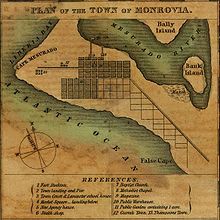Fort Stockton (Liberia)
Coordinates: 6 ° 19 ′ 10 " N , 10 ° 48 ′ 27" W.
The Fort Stockton was a fortification on the Capitol Hill of Monrovia in Liberia .
history
Fortified Dutch trading post
Since the middle of the 17th century, the Dutch West India Company used the natural harbor in the mouth of the Saint Paul River at Cape Mesurado as a trading post on the Pepper Coast . The Dutch founded a settlement with a landing stage and built a fortification on the highest point of Cape Mesurado - today in the western part of Capitol Hill . This fortress consisted of a rampart on the mountain, which was secured with several stone buildings for the occupation and palisades .
As a result of the successful development of the colonies in the Dutch East Indies and the Cape Colony, the interest of the Dutch in this trading colony on the Guinea coast waned . The station in Monrovia was abandoned in the 18th century and the fortress fell into disrepair. Today the remains can be viewed for a fee.
New establishment as "Fort Stockton"
With the re-establishment of the Monrovia settlement under the direction of Jehudi Ashmun by the American Colonization Society for the purpose of settling former slaves from the United States , the protection of the settlers and the anchorage became necessary. In the course of 1831, 46 supply ships anchored in the port of Monrovia. The ruins, known as Dutch Fortress , were renovated and named Fort Stockton - after Robert Field Stockton , a distinguished US naval officer who stood up for the protection of the settlements in the founding years of Liberia.
Coastal battery "Fort Norris"
The settlers expanded the outdated fortifications and built more entrenchments . At the same time, a coastal battery was built on the Cape . This was called Fort Norris and consisted only of the gun emplacements for the cannons. Because of the frequent rains, a permanent building had to be available there for the storage of gunpowder stocks and ammunition. The ingenious idea of using the lighthouse that was already planned for this purpose came up. The ground floor of the tower was designed to be particularly massive and served as a powder tower for decades .
The artillery armament of Liberia consisted of 15 cannons (decommissioned ship guns) and 3 smaller cannons. At times 5 guns were borrowed to other locations in the colony, but by 1840 all guns were ordered back. A pirate attack on the American supply ships anchored in the port of Monrovia proved that the fortifications, which had been built with great effort, were justified - the brig John from Portland and the schooner Bona from Baltimore were robbed and the settlers taken by surprise plundered.
Fight with the slave traders' trading town base
A major interest of American society was the suppression of the slave trade , which in the first half of the 19th century encompassed the coast of what is now Liberia and Ivory Coast and delivered slaves to Brazil and various islands in the Caribbean . Trading Town on the Atlantic coast near Buchanan , now in the area of the Liberian fishing village of Didi, was a base for the slave traders and a constant threat . The US Navy had sent a warship to the Liberian coast to protect the settlers and operated from Monrovia to arrest ships of the slave traders. The rulers in “Trading Town” took revenge for this interference in their “trading business” by attacking the previously spied Monrovia in alliance with a pirate ship and fleeing the settlers. Just a few days after this event, another US Navy warship arrived and immediately sailed for the slave traders' base. During the cannonade, the powder magazine of “Trading Town” was destroyed by a direct hit, and most of the crew and the pirates allied with them were killed. The tribes allied with the slave traders were thus deprived of a source of income and remained bitter enemies of the settlers for decades.
List of the first crew
Thanks to extensive correspondence, the names of the first commanders and the manning of the Fort Stockton garrison are known.
- James C. Barbour - Captain of the Liberian Citizens' Militia (Volunteers) and its commander
- Frederic James - Captain of Fort Norris Coastal Battery and Assistant Commandant
- AD Williams - 1st Lieutenant of the Citizens' Militia
- William L. Wearer - 1st Lieutenant, Coastal Battery
- Elijah Johnson - 2nd Lieutenant of the Citizens' Militia
- Jordan Williams - Ensign of the Civic Militia
- A. Curtis and Robert A. Barbour - sergeants of the civic militia
The troop strength was reported as 90 soldiers, all settlers capable of military service were sworn in as a citizen militia and provided the majority of the defenders.
Today's findings
The small settlement area in the city of Monrovia led to the fortress being abandoned 100 years ago, the ramparts and buildings were removed, the area is now overbuilt. The buildings of the coastal battery can no longer be found either.
literature
Selection:
- James Fairhead et al: Africa-American Exploration in West Africa . Four Nineteenth-Century Diaries. Indiana University Press, Bloomington (IN) 2002, ISBN 0-253-34194-9 , pp. 340 (English).
- Claude Andrew Clegg III .: The price of liberty. African-Americans and the making of Liberia . Ed .: University of North Carolina. University Press, 2004, ISBN 0-8078-5516-2 , pp. 81 (English).
- Henry Clay: The speeches of Henry Clay. A autobiography . Delivered in the Congress of the United States. James Maxwell, New York 1827, On the Colonization (English, limited preview in Google Book Search).



